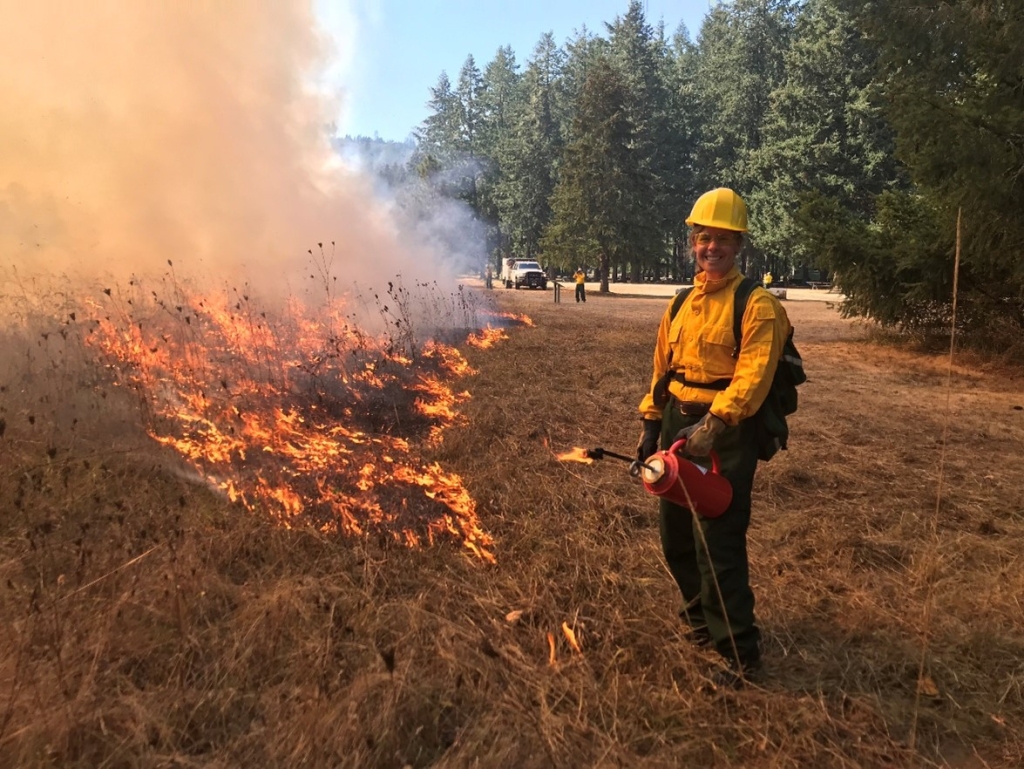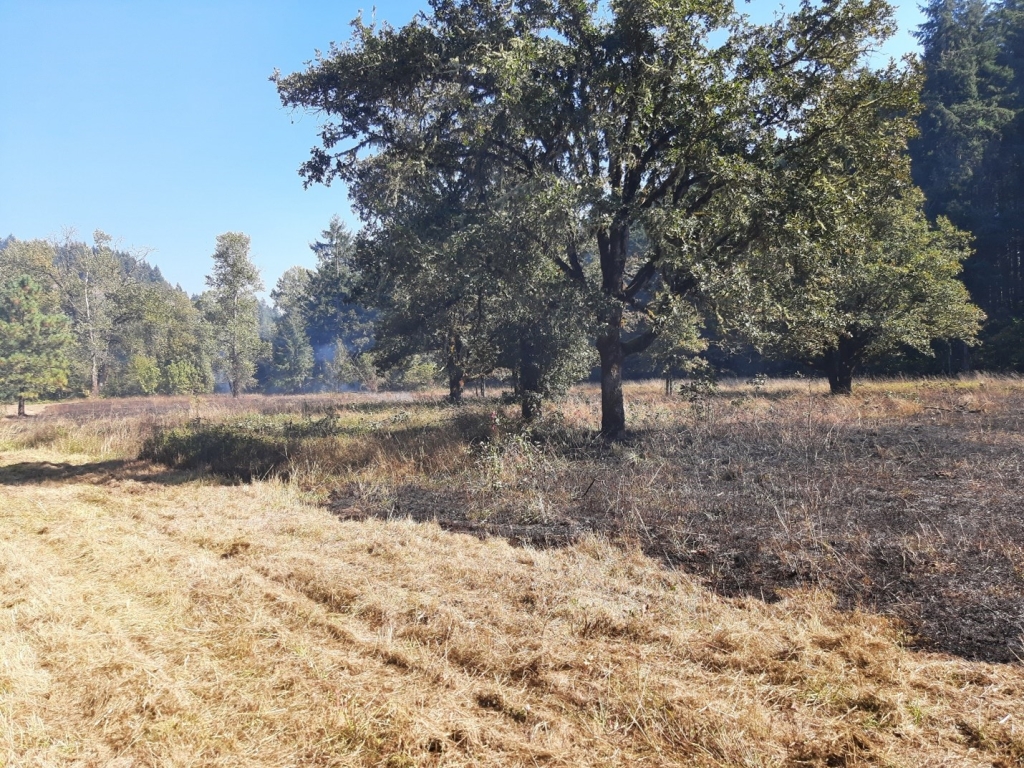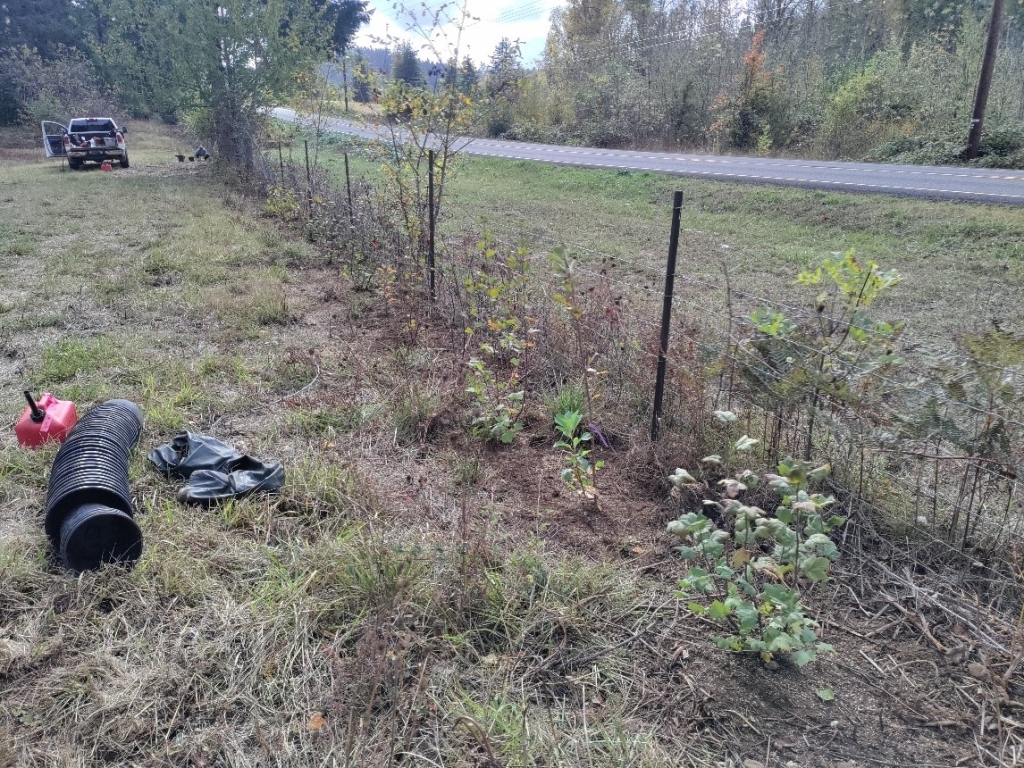Prairie Burn Project Comes to Fruition in 2022
By Jessica Celis and Rolando Beorchia
February 2023

On Saturday, October 1, 2022, the Bureau of Land Management (BLM) implemented a restorative prescribed burn at Dorena Prairie Area of Critical Environmental Concern (ACEC), a prairie/oak savannah located just west of Dorena Lake on the Northwest Oregon District’s Upper Willamette Field Office.
Formerly one of the more common ecosystems in the Willamette valley, prairies and oak savannas like Dorena Prairie are incredibly important, and increasingly rare ecotypes that are scattered across the Willamette Valley and throughout the Pacific Northwest. Since European settlement 95-99% of native prairie and oak woodlands have been lost to development, fire suppression, and agriculture; what is left is highly fragmented, and degraded by the invasion of woody and non-native species (Hamman et al. 2011). Prior to settlement, prairies and oak savannas of the Willamette Valley and foothills were maintained by fires set by indigenous people (Hamman et al. 2011).
Three hundred species of wildlife in the Willamette Basin, including 12 amphibians, 15 reptiles, 12 mammals, 40 birds and an unknown number of invertebrate species, are dependent on the preservation of these rare ecosystems. Fourteen of these wildlife species are listed as Bureau Sensitive. As least 375 vascular plants are highly associated with these habitats, several of which are listed as either Federally listed or Bureau Sensitive (Vesely and Rosenberg 2010, USFWS 2010). Planning for a prescribed burn at Dorena Prairie began in 2018—when IAE and the BLM met and discussed what was needed to restore the area from a non-native, perennial grass-dominated prairie to a prairie populated by a rich and healthy mix of native bunchgrasses and forbs. IAE and the BLM have partnered since 2010 to conduct prairie restoration at Dorena Prairie.
This parcel was first nominated as a BLM ACEC in 1995. It provides one of the few remaining examples of a Roemer’s fescue prairie in the Willamette Valley and special management is needed to ensure that the remaining native plant component of this community is not overtaken with non-native, invasive species like Himalayan blackberry (Rubus bifrons) and Scotch broom (Cytisus scoparius). Over the last 11 years, restoration efforts including mowing and manual treatment to control non-native, woody species have been successful at controlling these woody weeds, however these treatments have failed to mitigate the encroachment of the prairie by non-native, perennial grasses such as tall fescue (Schedonorus arundinaceus) or native shrubs like snowberry (Symphoricarpos albus).

With the completion of two National Environmental Policy Act documents in 2019 that analyzed the effects of a fully integrated weed management approach—including the use of herbicides and prescribed burning—land managers now have the tools to effectively manage and restore Dorena Prairie and other prairies across the Northwest Oregon District. These tools are incredibly important. Regional research has shown that the only effective means of restoring a prairie ecosystem is through repeated applications of burning, herbicide treatment, and most importantly, seeding and planting of native species (Stanley et al. 2011).
It was not until 11:30 a.m. on October 1st that conditions at Dorena Prairie were right for burning. The Upper Willamette Field Office Staff readied their drip torches. After a test burn, the lighting boss gave the ignition crew the thumbs up to start dragging their drip torches along the edges of the meadow and the fire line (Figures 1 and 2). Despite the fire not carrying on the shady side of the meadow, a large portion of the meadow charred, leaving the above-ground plant material dead and bare ground. These conditions are perfect for follow up herbicide treatment and planting/seeding of native species (Figure 3).

The week after the prescribed burn, IAE staff and volunteers planted 2,000 bulbs of eight species including harvest Brodiaea (Brodiaea elegans) and cat’s ear lily (Calochortus tolmiei) (Figure 4). Additionally, a diverse assortment of shrubs were planted along the south edge of the meadow to create a living fence that will act as a weed barrier between the meadow and Row River Road in addition to providing forage for wildlife (Figure 5).


On November 14, 2022, clear, dry skies and warm temperatures created the perfect conditions for post-fire weed treatment and seeding. Six acres of Dorena Prairie received a targeted glyphosate treatment followed by the broadcasting of native seed.
In the six weeks after the prescribed burn, only a few non-native species sprouted and regrew; true to their habits of opportunistic, post-disturbance invasion, Queen Anne’s lace (Daucus carota), velvet grass (Holcus lanatus), and tall fescue all produced new green shoots and open leaves.
The fact that weedy species tend to be the first to rebound after large disturbance offers an opportunity for an herbicide treatment that targets non-desired species while reducing the risk of harm to native species. IAE broadcasted a native seed mix at a high and competitive rate of 18 pounds per acre; in total, 90 pounds of native seed were added to Dorena Prairie (Figure 6). This multifaceted revegetation plan coupled with the prescribed burn and follow-up weed treatments will give us the best chance of success at restoring this meadow ecosystem.

After 11 years of conducting restoration work at Dorena Prairie without the full array of management tools available, IAE and the BLM are hopeful that the addition of prescribed fire and chemical treatments will help Dorena Prairie move from a prairie dominated by non-native grass to one with a diverse array of native prairie plants.
Citations
Hamman, Sarah T., Peter W. Dunwiddie, Jason L. Nuckols, and Mason McKinley (2011). Fire as a Restoration Tool in Pacific Northwest Prairies and Oak Woodlands: Challenges, Successes, and Future Directions. Northwest Science, Vol 85, No. 2.
Stanley, Amanda G., Peter Dunwiddie, and Thomas N. Kaye (2011). Restoring Invaded Pacific Northwest Prairies: Management Recommendations from a Region-Wide Experiment. Northwest Science, Vol. 85, No. 2.
Vesely, David G. and Daniel K. Rosenberg (Jan. 2010). Wildlife Conservation in the Willamette Valley’s Remnant Prairie and Oak Habitats: A Research Synthesis. Oregon Wildlife Institute report to the Interagency Special Status/Sensitive Species Program USDI Bureau of Land Management/USDA Forest Service.
U.S. Fish and Wildlife Service. 2010. Recovery Plan for the Prairie Species of Western Oregon and Southwestern Washington. U.S. Fish and Wildlife Service, Portland, Oregon. xi + 241 pp.
